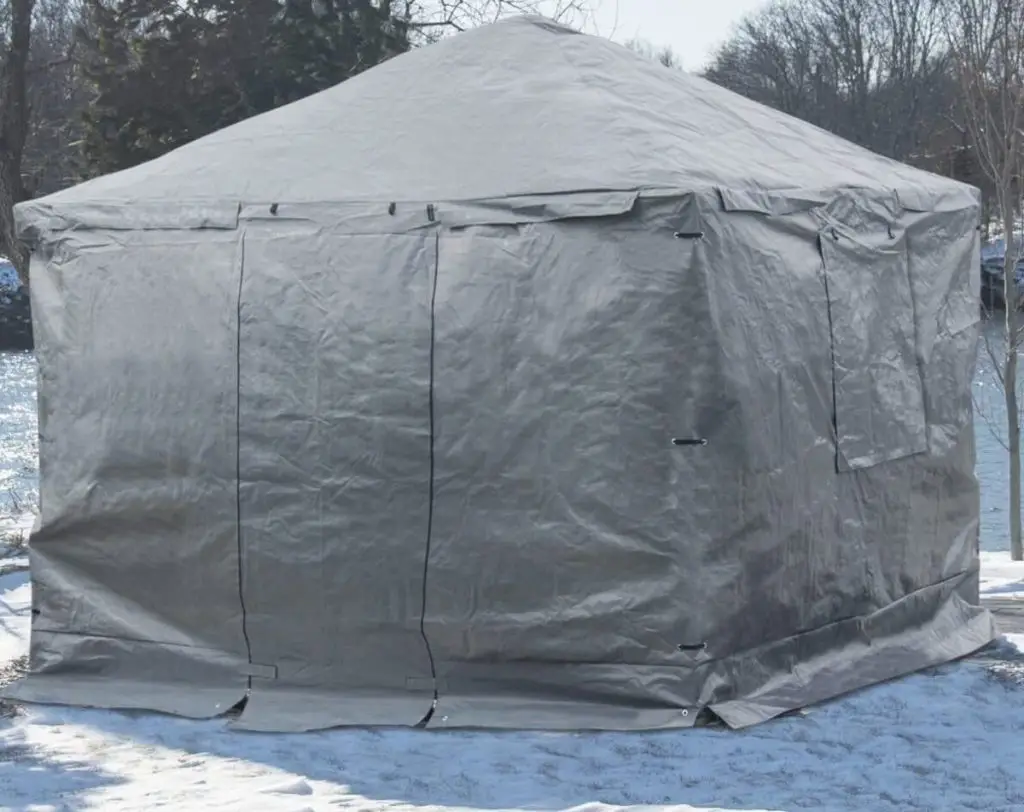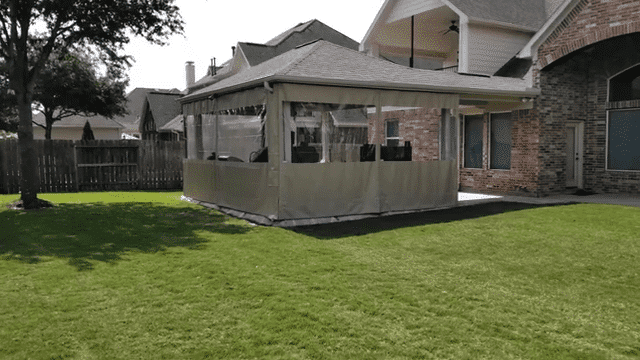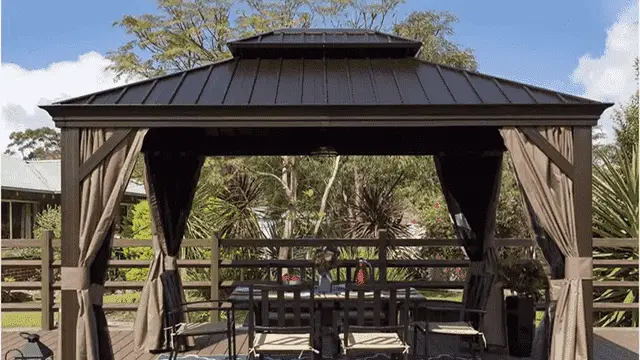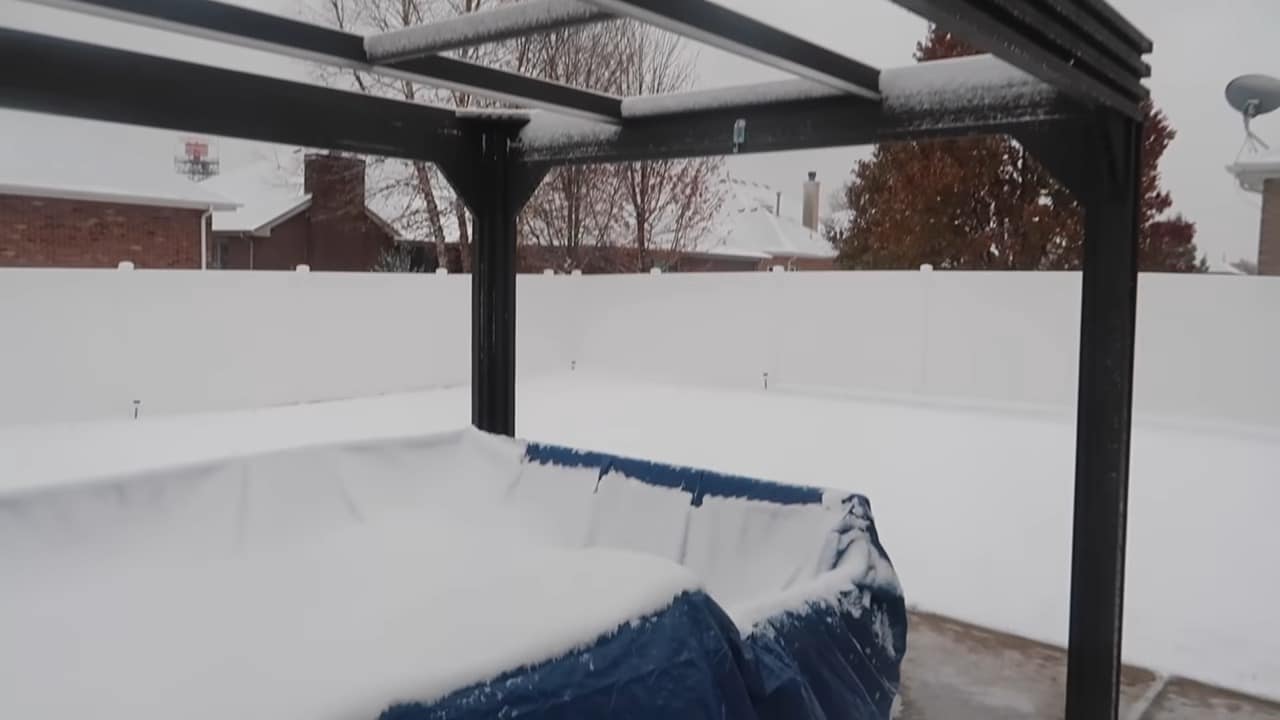If you have a gazebo and want to store it for the winter, there are a few things you should do to keep it in good condition. The first thing you need to do is clean it well. Make sure you clean the frame, canopy, and sidewalls carefully to remove any dirt or stains.
After cleaning, make sure the fabric is completely dry to prevent mould or mildew from forming. Finally, read and follow the instructions carefully to store your gazebo in the correct way.
By doing all of these things, you can help ensure that your gazebo will be in good condition and ready to use again when the weather gets warm.
How to Store Your Gazebo for the Winter: As the weather gets colder and the days get shorter, it’s time to start thinking about storing your outdoor furniture for the winter. This is especially important if you have a gazebo because you want to protect it from the snow and cold.
But before you put your gazebo away for the winter, there are a few things you need to do to make sure it’s stored in the right way. In this guide, I will provide all the details on how to store your gazebo for the winter.
How to Store Your Gazebo for the Winter –Expert Tips on
As we move towards winter, the weather is getting colder and the days are getting shorter. This means it’s time to put away our gazebos and move them inside. If you only use your gazebo during the summer months, it’s important to pack it up correctly and store it well so it lasts longer.
If you’re a trader, market stall vendor, or events worker who uses this equipment all year round, you need to learn the best way to pack up and store it, even if you don’t need to store it for long periods of time. This will help keep your gazebo in good condition and make it last longer.
Follow Instructions and Keep Bags
Make sure to keep the instructions that came with your gazebo in a safe place. If you use your gazebo often, you probably know how to fold and store it properly. But if you don’t use it very often, having the instruction manual can save you a lot of time and make it easier to take down.
Make sure to put all the small parts, like pegs, back in the bags they came in. Then, fold the gazebo and put it in its storage bag. If you follow the instructions and use common sense, it should be easy to store your gazebo.
Keep the Canvas Dry

It may seem hard, but it’s important to try to pack your pop-up gazebo canvas walls and roof when they are completely dry. This is especially important if you’re going to store the gazebo for the fall and winter and won’t use it again until the following year.
If you have a garden gazebo, it’s best to take it apart and let it dry in the sun before the weather gets worse. But if you can’t do that, you can pack it up even if it’s raining, and then let it dry overnight in a sheltered place like a warehouse, office, porch, or kitchen.
Store Appropriately
Choosing the right place to store your gazebo is just as important as the first two steps. The best place to store it during winter is in a cool and dry area like a shed, so it won’t get wet, mouldy or discoloured. Make sure to leave enough space for the storage bag so that nothing gets squished or ripped. This will also make it easier to access the gazebo the following year.
That’s it! Storing your pop-up gazebo is easy with these tips, which can also apply to other outdoor equipment like marquees or promotional flags. Following these steps will help keep your equipment in good condition for a longer time and save you money.
Remove any decorations or accessories from the gazebo
If you have a gazebo in your yard, it’s important to keep it looking neat and tidy. One of the things you can do is remove any decorations or accessories that are hanging or placed inside the gazebo. This might include things like lights, streamers, or potted plants.
By removing these items, you can create a more streamlined and uncluttered look for your gazebo. It will also make it easier to clean and maintain your gazebo, as you won’t have to work around these extra items.
Just be sure to store any decorations or accessories safely so that they don’t get damaged.
Check for any damage or wear and tear that needs to be repaired before storage
Before putting something away for storage, it’s important to inspect it to make sure it’s in good condition. This applies to items like furniture, clothes, or anything else that you want to keep safe until you need it again.
For example, if you have a piece of outdoor furniture, like a chair or table, you should check it for any damage or signs of wear and tear. If you find any problems, it’s a good idea to fix them before storing the item.
This will help ensure that the item lasts longer and stays in good condition for future use.
Disassembling the Gazebo
If you have a gazebo in your yard, you might need to take it apart at some point. This process is called disassembling the gazebo. It involves removing all the pieces of the gazebo so that it can be stored or moved.
Before you start disassembling the gazebo, it’s a good idea to read the instructions carefully, so you know exactly what to do. You’ll also need some basic tools, like a screwdriver or wrench, to help you take it apart. Once you’ve disassembled the gazebo, you can store it in a safe and dry place until you’re ready to use it again.
Store All Screws and Bolts in a Labelled Container
When you’re disassembling something, like a piece of furniture or a gazebo, you’ll usually need to remove screws and bolts. These small pieces are easy to lose, so it’s important to keep them organised. One way to do this is to store them in a labelled container.
This can be a plastic bag, a small box, or any other container that will keep them together. Before you store the screws and bolts, make sure to label the container with a description of what they belong to.
This will make it easy to find them again when you need them. Keeping screws and bolts organised will save you time and frustration when it’s time to reassemble the item.
To Protect A Gazebo In Winter

Now that summer is over, you’ll need to start thinking about taking care of your gazebo during the winter. Whether you plan on using it during the colder months or you want to store it away until next year, there are some important steps you’ll need to take to keep your gazebo in good condition.
To help you out, we’ve put together a list of simple maintenance and storage tips that will help protect your gazebo from the winter weather. By following these tips, you can ensure that your gazebo stays in great shape all year long.
Furniture should be covered or removed
If you have any outdoor furniture inside your gazebo, it’s a good idea to protect it during the winter. This means either covering it up or removing it altogether. During the winter, it’s usually wetter and windier, and this can cause your furniture to get damaged or damp.
If it gets very windy, your furniture could even be thrown around and damage the gazebo frame. If you plan on keeping your gazebo outside during the winter, it’s important to keep an eye on the weather forecast and make sure everything is secure and protected.
Watch out for debris or snow
As the seasons change, your gazebo might start to get covered in leaves, branches, and other debris. If you leave the rotting leaves on the canopy, it can cause damage to the waterproof coating, so it’s important to regularly clear the top of your gazebo to keep it protected.
Another thing to watch out for is pools of rain or snow that can build up and weigh down the structure. While snow might look pretty on top of the gazebo, it can be very heavy and cause the canopy to tear or the frame to collapse. It’s important to only keep your gazebo outside when you’re using it.
Leaving it out in harsh weather conditions for long periods of time can cause unnecessary damage. Keep reading for more tips on how to store your gazebo during the winter.
Keep the gazebo clean by thoroughly cleaning it

As the season changes, it’s a good idea to give your gazebo a thorough cleaning. During the summer months, you may have had guests or customers over, and the canopy and side walls might have food, drink, or dirt stains. If you don’t clean them, they can become mouldy or stained, especially during the damper months.
If you’ve been cleaning them regularly, you can wipe them clean with warm, soapy water while they’re still on the frame. But for a more effective clean, it’s best to remove the canopy and sidewalls and clean them with a soft brush and warm, soapy water. You can then rinse them with clean water to remove any residue.
The best way to store a gazebo for the winter
Removing and storing a gazebo is easy, especially with pop-up gazebos that can be taken down in under a minute. However, you must follow the steps below to keep your gazebo in good condition for next summer.
If you store it incorrectly, it might develop mould or mildew, which would be unpleasant to discover when you take it out on the first sunny day next year. But don’t worry, if you follow the right steps, you can avoid this problem.
Dry the canvas completely
To keep your gazebo in good condition for next year, it’s important to make sure that it’s completely dry before storing it. If you pack away a wet or damp gazebo, it’s likely to develop mould and mildew, which can damage the fabric and cause unpleasant smells.
If your gazebo has been exposed to rain, it’s best to wait until it’s dry before you pack it away. Rushing the process can cause damage to your gazebo and it’s important to be patient to avoid any costly repairs later.
Clean the frame, canopy and sidewalls Deeply

To store your gazebo during winter, it’s important to give it a good clean. You should remove any dirt, spills, or stains from the frame, canopy, and sidewalls. This is because if you store it with any of these on it, it could attract mould or bad smells.
To clean your gazebo, take off the canopy and sidewalls and lay them out on the ground. Use warm, soapy water and a sponge to clean the frame. For the canopy and sidewalls, use a soft brush and warm, soapy water to scrub away any stains. Rinse the canopy and sidewalls with clean water from a hose.
Once you’ve finished cleaning, make sure to let everything dry completely. You can leave it out in the sun or somewhere dry like a shed overnight. After it’s completely dry, you can pack it away for the winter.
Storage instructions should be followed
The majority of our gazebos come with a free storage bag which is designed to keep your gazebo dry and protected – if stored correctly, of course.
If you still have your instructions which would have been supplied with the initial purchase, give these a read to follow any specific storage instructions. If you don’t have these anymore, don’t worry, simply read the following guidance:
Make sure to carefully place the dry gazebo into the bag without unnecessary force to avoid damage to the bag, frame or canopy. Once safely in the bag, you’ll need to find a cool, dry area to store it with enough space to avoid tearing the bag.
Remember to make it easily accessible and ready for the first sunny day of next year!
Remove any snow buildup from the cover
Make sure to clear any snow that has accumulated on top of your gazebo cover. Snow can be very heavy, and if it’s left to sit for too long, it can cause the cover to tear or even collapse the frame. So, if it snows, make sure to remove it as soon as possible to keep your gazebo safe and sound.
Check for signs of pests or moisture damage
Before storing your items, it’s important to make sure that they don’t have any signs of damage from moisture or pests. This can include things like water damage, mould, mildew, or signs of insect or rodent infestation. By checking for these issues, you can prevent further damage and keep your stored items in good condition for the next time you need them.
FAQs
Q:1 Can you leave your gazebo up for winter?
You can leave treated and composite wood gazebos outside all year. Treated wood is stronger than untreated wood and can handle scratches, stains, heat, and bad weather. It’s a better choice for your gazebo because it needs less maintenance than untreated wood.
Q:2 How do you store a gazebo?
Storing a wet or damp gazebo after use can cause mildew to grow. So, before packing it up, make sure that it is completely dry. After that, fold the cover neatly and put it back in its storage bag. It’s best to store the gazebo in a dry and clean area, away from the ground and any animals that may cause damage.
Q:3 Do you have to bolt down a gazebo?
To avoid accidents, it’s important to secure your gazebo properly to the ground. There are three ways to anchor your gazebo to pavers: you can drill the gazebo legs directly into the pavers, drive concrete footers between pavers, or use weights to keep it in place.
Q:4 Can you get struck by lightning under a gazebo?
It’s not safe to be under a tree or in a gazebo during a thunderstorm unless the structure has wiring and plumbing. Rubber boots won’t protect you from lightning strikes, so avoid tall structures if you’re outside during a storm.
Q:5 What is the best way to secure a gazebo?
One of the easiest ways to secure your gazebo is by using tent pegs and rope. Most gazebos come with ropes already attached to them that you can use for securing them. You can add extra rope directly to the frame for extra stability if needed.
Conclusion
In conclusion, properly storing your gazebo for the winter is crucial to ensure its longevity and that it’s ready to use again when the warm weather returns. By following the steps outlined in this guide, you can avoid damage to your gazebo from weather, pests, and other factors.
Remember to clean and dry all components before storage, remove any snow or debris buildup, and store them in a dry and secure location. By taking these simple steps, you can enjoy your gazebo for years to come.
We hope you will be well aware of How to Store Gazebo for the winter, after reading this comprehensive guide. If you have any questions. Feel free to comment below!


